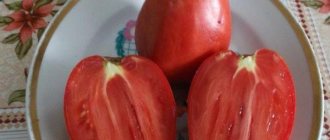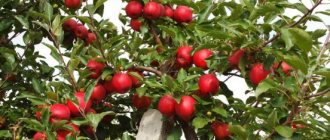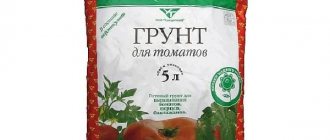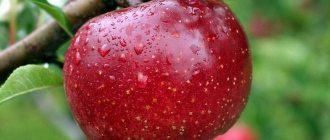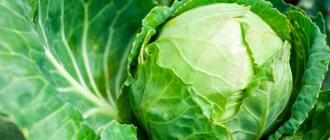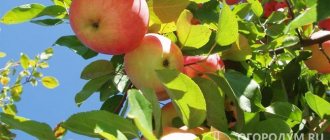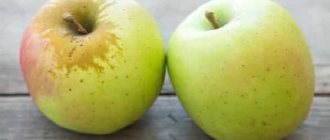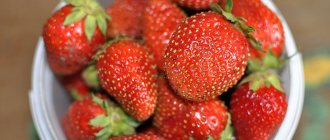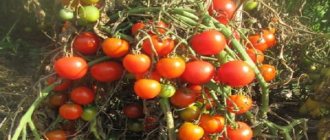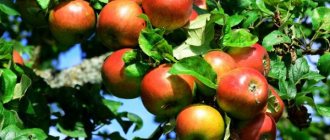History of variety development
It is not known for certain how this variety of apples was bred, so most sources say that the Moscow Grushovka apple tree is the fruit of folk selection.
Photo of the Moskovskaya Grushovka apple tree
The variety was first described by A. T. Bolotov as a widespread apple tree grown on an industrial scale and in private gardens.
Moscow Grushovka apple tree: description and characteristics of the variety
The Moscow Grushovka variety of summer apple tree is distinguished by its considerable height - up to 6.5-7 m in height
. The crown is thick and voluminous, its shape can be oval or pyramidal. On average, the volume of the Moscow pear can exceed 7-7.5 m. The bark of the main trunk is brown in color with an orange or yellow tint, and in young branches the color of the bark is more intense, dark cherry.
The shoots are quite powerful and strong, well leafy. The foliage is slightly elongated, medium in size, with a characteristic shine on the outer leaf blade. The color of the leaves is deep emerald. The veins are thin and clearly visible.
The blooming buds are quite large, soft pink in color; after blooming, the petals become white with a slight pinkish tint.
Apples at Moscow Grushovka do not grow too large - on average they weigh 70-75 g, the heaviest ones can reach 110-115 g
. The shape of the fruit is round, slightly flattened. The skin is thin, practically unnoticeable when eaten, covered with a thin coating of wax; ripe apples are yellow in color with a greenish tint and stripes of red or pink.
Brief overview of the Moscow Grushovka apple tree - video
The pulp is slightly compacted, very juicy, the aroma is pleasant, typically apple. A fully ripened pear has a sweet taste with a slight sour taste. 100 g of product contains only 47 kcal.
Ripe apples do not stick well to the branches, so this variety has a lot of carrion.
Unfortunately, the ripe fruits of the Moskovskaya Grushovka variety do not tolerate transportation very well; they can be stored for no more than a month, then the taste of the apples deteriorates, they become “wadding” and almost tasteless.
Therefore, it is advisable to process the harvested crop as soon as possible after harvesting.
PLANTING AND CARE OF APPLE TREE!
Planting and caring for apple trees in open ground
In the last century, this variety was actively grown on an industrial scale on collective and state farms. But recently, Moscow Grushovka has been grown only in summer cottages.
The collected fruits can be used for food, made jam or jam, extracted juices, dried.
The variety is highly resistant to frost and some diseases characteristic of other varieties of apple trees.
Only the resistance of the Moscow Grushovka to scab is low.
Main characteristics of the variety
From wild-growing Grushovka, breeders have developed more productive and disease-resistant varieties - Grushovka early and Grushovka winter. Their fruits are slightly larger than those of the mother variety, but the main difference is the ripening time of the apples.
Descriptions of the varieties Grushovka early, winter and Moscow are given in the table
On a note. Grushovka is considered the record holder for frost resistance in the Moscow region. A characteristic feature of the variety is extended ripening. In home cultivation, this is a godsend; the fruits can be gradually picked from the tree for fresh consumption and preparations. This feature does not allow the variety to be grown on an industrial scale.
Advantages and disadvantages
According to gardeners, the parent variety Grushovka has a pleasant taste, but requires preventive measures to combat scab and leaf rollers. This apple variety has the following advantages and disadvantages:
When growing a large harvest, it is worth considering how long apples are stored. This variety is not very lightweight.
Description of the tree
The lifespan of a wild species reaches 60 years; young trees begin to produce crops in the 4th year of development. Mature trees grow up to 7 meters in height and are distinguished by a voluminous pyramidal or spherical crown. Without annual pruning, the apple tree forms a dense crown. Timely pruning improves air and light access to the fruits and increases the likelihood of healthy apples developing.
Photo. Tree Grushovka Moskovskaya
To get a good harvest, it is advisable to plant pollinators in the vicinity of Grushovka. Agronomists call the following varieties the most suitable:
Important! Without pollinating trees, the number of ovaries decreases and the yield falls.
Description of apples
The average weight of the fruits of wild Grushovka is about 50-60 g. The ripe harvest is colored light green with a yellow tint. The sunny side acquires a pinkish tan. The pulp is juicy, pale yellow. The taste is honey with sourness. The tasting rating of apples is 4.4 points. The peel of the fruit is soft, so apples are not recommended for long-term storage and transportation.
Recommendation. It is advisable to store apples removed from the tree for no more than 10-14 days. They are suitable for preparing dried fruits, jams, purees, juices, compotes.
Drought and frost resistance
The crop is characterized by good frost resistance. In snowy winters, the branches and root system can withstand severe frosts. However, the variety is not resistant to drought. To preserve the ovary and the harvest, the tree must be watered 2 times a week with 10-15 liters in the circle around the trunk.
Productivity, ripening time
Harvesting depends on the proximity of pollinators and a certain cyclicity. The variety is characterized by the concept of a productive or lean year. The first fruiting occurs at 4-5 years. In this case, no more than 3-4 fruits are left on the tree. The second fruiting brings about 10 kg of fruit. From a mature tree, up to 80 kg of fruits are collected once every 4 years, the rest of the time 40-50 kg. Apple picking begins at the end of July and ends in mid-August.
Resistance to diseases and pests
One of the negative features of culture is susceptibility to the following diseases:
- scab,
- moniliosis,
- black cancer
Often during prolonged rains, trees are affected by fungal diseases. For the purpose of prevention, the following measures are necessary:
- autumn cleaning of fallen leaves, rotten and diseased fruits;
- whitewashing the trunk with lime, digging, spraying the area around the trunk with copper sulfate before wintering;
- Spring treatment of the trunk and branches before the first greenery appears, as well as before flowering, helps to avoid diseases and pest attacks.
Important! It is important to spray against leaf rollers, aphids, and scab before flowering so that pesticides do not get into the ovary.
Pollinator trees for the Moskovskaya Grushovka apple variety
The summer apple tree variety Moskovskaya Grushovka is self-sterile, so other tree varieties with a similar flowering period should be planted nearby. Pollinator trees do not have to be hybrids; they are usually perfectly adapted to the growing area.
The best pollinators for the Moscow Grushovka apple tree are:
- Antonovka;
- Padding;
- Anise Striped;
- Cinnamon;
- Bellefleur is Chinese.
For better cross-pollination, it is necessary to plant at least 3-4 different varieties of apple trees nearby.
Features of the view
The pear apple variety appeared as a result of natural evolutionary processes. The tree can grow up to 8 m in height and has a rounded crown. Flowering is expressed by delicate pinkish buds. The fruits are not too large and have a round shape. The color of apples may vary. The description of the pear apple tree can be supplemented by the fact that its fruits are very sweet and juicy . When overripe, apples become mealy.
The description of the Moskovskaya pear apple tree variety would be incomplete unless it is said that this is an early ripening species - the first harvest can be harvested in early August. Since the fruits ripen unevenly, harvesting continues throughout the month. The apple tree lives for a very long time and bears fruit for 50 years.
This early variety is not used for commercial purposes because the fruits do not keep well. Gardeners in describing the Moscow pear tree agree that it is unpretentious, produces high yields and fruits with a wonderful taste . The only downside is that other varieties need to be planted nearby so that the pear can be pollinated.
Productivity of the Moskovskaya Grushovka apple tree variety
In one place, this variety grows and actively bears fruit for up to 60 years; the first harvest on Moskovskaya Grushovka occurs early - 4 years after planting the seedlings in a permanent place.
Photo of fruit tree Moscow Grushovka apple tree
Already the first harvests collected from this apple tree are amazing - they can reach 10-15 kg, and with an adult Moscow Grushovka you can harvest up to 100 kg of ripe, juicy and sweet fruits.
However, fruiting is not stable - usually this fruit tree bears fruit every other season, but very abundantly.
Diseases and pests of apple trees Moscow Grushovka
The main disease that damages many varieties of apple trees, including Moscow Grushovka, is scab.
This disease damages not only the foliage of fruit trees, but also the apples themselves, which gradually turn black, crack, become deformed, or become covered with spots of varying sizes.
Diseases in the apple tree:
Chlorosis on the apple tree Rust on the leaves of the apple tree
To prevent the occurrence of scab on the Moscow pear tree and other fruit trees, it is necessary to remove all plant debris, fallen leaves, and carrion from the trunk circles every year in the autumn, dig up the trunk circle, all wounds on Treat the trunk and branches with special disinfectants.
Photo of apple tree disease - scab
For scab on trees, it is recommended to treat them with special preparations - Strobi, Skor and other similar means.
GOOD VARIETIES OF APPLE TREE:
Ligol apple tree Lungwort apple tree Columnar apple tree Ostankino
Pests and diseases
Grushovka shows weak immunity to a number of diseases. She is especially susceptible to scab.
Most often, scab “attacks” in rainy summers.
In order to avoid its spread, a number of measures must be taken:
- Every fall, clean the garden or garden plot of fallen leaves and carrion.
- Every year, carefully dig up the soil over the entire area of the tree trunk circle.
- Treat all cracks and wounds with special disinfectant solutions and cover them with garden varnish.
In the spring, you need to inspect the trunk of the apple tree, looking for cracks that arise from temperature changes. Frost holes must be cleaned and covered with garden varnish.
If scab lesions are detected, it is necessary to treat with Bordeaux mixture (1% or 3%).
To prepare this mixture you need:
- prepare 10 liters of clean water;
- 100 grams into it ( 1 sachet );
- stir and carefully add a bag of quicklime ( 100 g ).
The result is a 1% solution of Bordeaux mixture. To obtain a 3% solution, the amount of dry components is increased by 3 times. This product (3%) is sprayed on apple trees only in the spring. All further treatments are carried out with a 1% solution. Spraying is done from all sides of the tree.
In the fight against scab, the drugs “ Skor ” and “ Strobi ” are often used. They are sold in ampoules and diluted at the rate of 1 ampoule/10 liters of clean water.
Advantages of the variety
The main advantages of Moscow Grushovka include:
- excellent productivity;
- good taste of ripe fruits;
- early ripening of the crop;
- the versatility of the collected fruits;
- early ripening of the variety;
- high frost resistance of the Moscow Grushovka apple tree.
Apple tree summer variety Grushovka Moskovskaya - video
but this apple tree also has a number of serious disadvantages:
- the variety is self-sterile, so the presence of pollinating trees is required;
- apples do not tolerate transportation well and are poorly stored - no more than a month;
- due to their small size, the fruits do not have the best appearance in comparison with other varieties;
- fruiting is good, but not stable - this variety of apple tree usually bears fruit every other season;
- the variety has low resistance to scab.
Moscow Grushovka apple tree - planting seedlings
The Moscow Grushovka fruit tree is most often grown in central Russia, the Moscow region and other regions with similar climatic conditions.
But thanks to its high resistance to frost, Moscow Grushovka can be successfully grown even in the Urals or Siberia.
Photo of a diagram of the correct planting of a fruit tree
Although this variety of apple tree belongs to unpretentious fruit trees, there are a number of agrotechnical requirements when planting and further growing Moscow Grushovka, without which you can be left with virtually no harvest.
The area for planting this apple tree should be on a level, well-lit place; moisture should not accumulate in the soil, the stagnation of which is detrimental to the Moscow pear tree. And in the shade, the apples on this tree will grow small and sour. The groundwater level should be no closer to the ground surface than 2.5-3 m.
Photo of planting an apple tree
Planting holes should be about 1 m in diameter and up to 0.6 m deep.
A few days before planting the Moskovskaya Grushovka apple tree, fertilizers are added to the holes - at least 24-26 kg of humus is added to each hole. A stake is driven in near the center of the hole, to which the tree is tied so that it takes root better and leans to one side under gusts of wind.
A Moscow Grushovka apple tree seedling is placed in the center of the hole, and its roots are carefully straightened along the diameter of the hole. Then the hole is filled with garden soil, which needs to be slightly compacted. At least 3 buckets of water are added to each tree.
Autumn whitewashing
In the autumn, the tree must be whitened.
This is done in the second half of November and is necessary, first of all, to protect the crop from moss, lichen, pests, fungal spores and other pathogens of various diseases.
Lichens appear in conditions of high humidity, which often happens on neglected apple trees with an excessively dense crown.
Whitewashing is carried out as follows:
- All small wounds, cracks and various types of holes in the tree bark are treated and sealed with garden varnish.
- A solution is prepared from 2 kg of quicklime, 1 kg of fatty clay and 6 liters of warm water. All this is thoroughly mixed until a homogeneous, slightly thick structure is achieved.
- Whitewashing must be carried out on a dry, rainless day.
Lime whitewash disinfects the bark of the apple tree and protects against sunburn.
- The mixture covers not only the trunk, but also the bases of large branches.
Further care for the Moscow Grushovka apple tree
In order for young trees to develop more intensively, it is recommended to cut off about a third of all flowers during the first flowering. And at the ripening stage, you need to remove about half of all the fruits. This is how experienced gardeners ration the harvest. The remaining fruits will be large, very juicy and sweet.
Further care for the Moscow Grushovka apple tree - video
This tree does not tolerate high soil moisture, but periods of drought are also not for Moscow Grushovka.
In order for this fruit tree to actively grow and develop, it is necessary to water it once every 2-3 days.
Stop watering after harvesting - in the last ten days of August, so that the apple tree finishes its growth and devotes all its energy to preparing for the winter period.
Also, after each watering, it is recommended to loosen the tree trunk circles with the obligatory removal of weeds.
Feeding apple trees of the Moskovskaya Grushovka variety
In the first season after planting, fertilizing is not required - if all necessary fertilizers were added to the holes during planting. It is enough just to regularly water the apple trees and loosen the tree trunks.
Photo of feeding an apple tree
Starting from the next season, feeding the Moskovskaya Grushovka apple tree is carried out according to the following scheme:
- in early spring, 9-11.5 kg of rotted horse manure or humus is added to the tree trunk circles for each square of area;
- 500 g of urea can be used as mineral fertilizers;
- in the fall, complex mineral fertilizers that lack nitrogen are applied to the trunk circles of the Moskovskaya Grushovka apple tree. For each square of area, 35-40 g of such fertilizer is sufficient, which is scattered over the surface of the soil and then covered during autumn digging.
Pruning the Moscow Grushovka apple tree
The first pruning of the Moscow Grushovka apple tree is carried out a year after planting. In this case, the central trunk is shortened by about 40 cm, and the skeletal branches and side shoots - by about 1/3. Subsequent pruning of the Moscow Grushovka is carried out as necessary.
Photo of apple tree pruning diagram
Care
The importance of watering
Moscow pear is an apple tree that does not tolerate drought. Required:
- before watering, loosening the soil around the trunk along the diameter of the crown;
- weekly one-time watering, 2-3 times during drought;
- spill 20-30 liters at a time;
- stop watering by September.
Fertilizers and tree trunk care
They feed Moscow Grushovka a year after planting the seedling:
- in early spring, urea and rotted manure;
- in the fall with Kemira or Fertik fertilizer.
Fertilizers are distributed around the trunk and dug well. During the summer, the circle should be loosened and weeded, cleaned of falling ovaries, affected fruits and leaves.
Trimming
Timely pruning is designed to:
- thin out the crown to avoid scab;
- select dry, diseased and damaged branches;
- make harvesting more accessible;
- prepare trees for winter.
Sick and pest-damaged branches are burned. The cut areas are generously covered with garden varnish.
Protection from pests and diseases
The worst enemies of the Moscow Grushovka are the fungal infection of the apple tree with scab and the codling moth.
Scab is especially active in humid climates. To effectively combat this disease it is recommended:
- trim and then burn the affected branches;
- destroy fallen leaves and spoiled fruits in a timely manner;
- treat the crown and the ground under it with copper sulfate;
- whiten the trunk before wintering;
- dig up an apple tree for the winter;
- cover wounds with garden varnish.
Of the special preparations, the most suitable are:
- “Strobe” - trees are treated with it in early spring;
- "Skor" - for prevention in the fall.
You can fight the codling moth:
- peeling off the bark under which the cocoons are hidden;
- catching butterflies and preventing worms from climbing up the trunk;
- insecticides;
- pheromone traps;
- growing nearby plants that repel the codling moth;
- attracting insect enemies of the codling moth (riders).
One pheromone trap for 5 trees almost completely rids the garden of 20 types of pests. It is not dangerous for humans and animals.
Preparing for winter
The Moscow pear tree, like any other apple tree, is usually (maybe sometimes frivolously) not covered for winter. In addition to pruning and other sanitary measures taken after harvesting, it is prepared for possible attacks by rodents. To do this, the trunk is wrapped in rags, cut plastic bottles, spruce branches, and fluttering black “T-shirt” bags.
Reviews of the Moscow Grushovkat apple tree
Olga, 44 years old, Moscow region: My parents planted Moskovskaya Grushovka on our plot 20 years ago. This tree has been bearing fruit well for many years - we are tired of harvesting. From the collected apples we make most of the juices, which are sweet and very aromatic, and then we drink them all winter. We also partially cut the carrion for drying, and in winter we cook compotes. The only drawback of this variety, in my opinion, is that the fruits do not last long - no more than a couple of weeks.
APPLE TREES!
Amber Necklace Apple tree Moscow Necklace columnar
Natalya, 50 years old, Volzhsky: One of the most fruitful summer apple trees in my garden is Moscow Grushovka. It has been growing in my garden for more than 13 years, and every year we collect at least 80-90 kg of ripe apples from under it. I extract juice from them, and my husband makes cider. The tree is quite unpretentious; you just need to remember to water it and feed it periodically.
The early summer apple variety Moskovskaya Grushovka still remains one of the most popular among Russian gardeners due to its high yield, frost resistance and good taste of ripe fruits.
Reviews from gardeners
Most gardeners leave positive reviews about this variety. They are impressed by the early ripening and excellent taste of Grushovka apples. The rich vitamin composition of the crop, as well as its abundance, also plays an important role.
Try planting Grushovka in your garden, you will definitely like it!
Most often, the fruits are used for canning and the production of homemade juices and wine, since their fresh shelf life is quite short. Many people dry Grushovka, getting an excellent supply of vitamins for the winter. Gardeners also note high winter hardiness, thanks to which the apple tree takes root even in the most northern regions.
Many summer residents like the long life of the tree, thanks to which several generations of the same family can enjoy its fruits.
